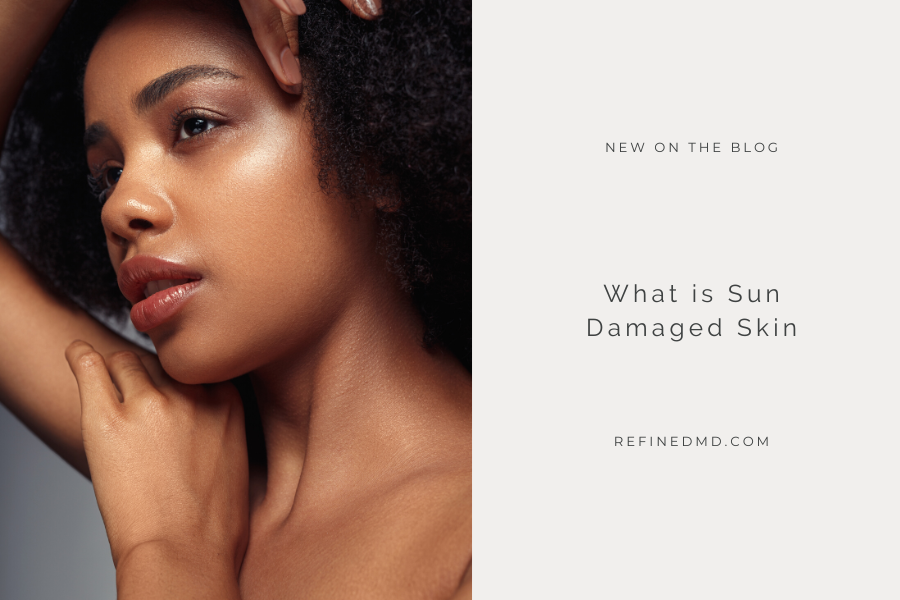
28 Dec What is Sun Damaged Skin?
Even if you do a fantastic job of protecting your skin from UV damage now, you probably weren’t quite as diligent as a child (and your parents had outdated information on the reality of sun damage). RefinedMD is dedicated to helping you comprehensively protect your skin now and in the future, and to reversing sun damage—including damage you might not even see.
The most common signs of sun damage immediately after exposure are dry skin, a sunburn, a tan (an increase in melanin, which is your body’s defense mechanism), and actinic keratosis. Actinic keratosis is a little bump that might look scaly and turn brown, yellow, pink, or red. It’s different than a sunburn or suntan because it’s permanent unless you undergo in-office treatment. Your dermatologist can remove it, but these little bumps can also be a red flag that you’re at an increased risk of skin cancer. It’s estimated that up to 15% of actinic keratoses become squamous cell carcinoma, one of the most common types of skin cancer.
Long-Term Signs of Sun Damage
A lot of people think that once their tan or burn has faded, the sun damage from a particular event has run its course. However, sun damage can also change the skin’s collagen. This results in what’s called “photoaging,” or premature skin aging due to sun exposure. Photoaging is what leads to fine lines and wrinkles as the collagen in the deep layer of the skin is changed from UV exposure.
Actinic purpura, or bleeding from vessels right below the skin’s surface, can also occur over time. UV radiation harms the collagen structure that supports the skin around the small blood vessels. As we age, this particular collagen becomes even more vulnerable, and the risk of rupturing is greater.
The more we’re exposed to the sun or go out unprotected (even on cloudy days), the more our skin gets damaged. The risk for all types of skin cancers, including malignant melanoma, also increases the more we subject our skin to sun damage. “Age spots,” such as increases in brown spots on the skin or moles, are actually signs of photoaging. However, it can take several years after a sun damage event for these types of photoaging to occur. That’s why it’s so difficult for patients to link their photoaging to a single event.
What to Do to Prevent and Treat Sun Damaged Skin
A dermatologist is the best expert to work with if you’re worried about sun damage. This professional can assess your degree of sun damage during an examination. If you have fair skin, you’re at a bigger risk of sun damage and skin cancer because you don’t have as much melanin as other people to naturally protect yourself. Seeing a skin expert at least once a year for a “skin check” is the best approach to preventing and treating sun damage. During these exams, a biopsy of any strange mole or actinic keratosis happens (if recommended). Only a biopsy can reveal if an area of the skin is cancerous, pre-cancerous, or benign.
Keep Clear of Sun Damage
Your dermatologist can also treat signs of photoaging with a variety of techniques including laser therapy, chemical peels, microneedling, and more. You can also find the best skin care products for you at RefinedMD, including top of the line sunscreens, moisturizers, cleansers, and toners. An at-home regimen with high quality products is critical to treating and protecting your skin moving forward.
It’s always best to prevent sun damage when possible, but most people are going to show signs of UV damage at some point. That sunburn you had as a teen might show up as brown spots when you’re in your 30s or 40s. For our parents’ generation, little could be done—or the only option was painful chemical peels that took weeks to heal. We’re living in an era where you can undo sun damage quickly and easily with little to no downtime. So combine prevention with treatments for skin that is protected and beautiful.
To learn more about treatment options and medical-grade topicals, or to schedule your skin check, get in touch with RefinedMD today. Give us a call during business hours or fill out the online form right now.
